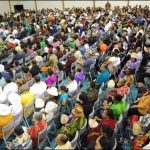Part 3: A brief theology of vision statements
In this brief series I have been suggesting that it is very important to have space within your theology of church for bathroom supplies, email lists, and difficult aunts — I have been saying, that is, that it helps us to remember that as well as all the other things it is, the church is a creature. Now I want to show how remembering this can help us by talking about that peculiar phenomenon of modern church life, the vision statement. Let me simply point out a few things.

To begin with, we should notice that a whole lot of the concerns that lie behind vision statements are worth worrying about and paying attention to. Vision statements are often written in order to get a handle on where a community is up to, where it’s going, what its local identity means, what should be prioritised, how budgets should be constructed, and so on. These are things that are worth paying attention to. Why? Because the churches are creatures: they are groups of particular, embodied people, in a particular place, with particular demographic and socio-economic profiles. Groups like this need to organisation and planning. There is also no reason why some wisdom that seems to apply to other groups like this — such as the idea of having a “vision statement” or a “mission statement” or a communications strategy — should not be somehow helpful as we think about these questions. A vision statement can be thought of as an attempt to responsibly take stock of the kind of creature this church community is, and the particular creaturely conditions, history, and possibilities that seems to be open to it.
However, there is great need for caution. Because although a church is a creature, it is not merely a creature, and must not fall into the temptation of thinking of itself as bound by material possibilities and merely human logic. The secular wisdom from which the ideas of vision statements are drawn, on the other hand, operates on precisely these principles: what can be achieved, what is possible, what can be measured. A church cannot afford to succumb to this way of seeing itself and imagining its future. In my experience, processes of formulating vision statements sometimes get stuck on just these questions, worrying about seeming to force God’s hand, or underestimate what he can do. What has happened here is that a legitimate desire to be conscious of a church’s creaturely reality and situation has bumped up against consciousness that our God is able to do far more than we ask or imagine (Eph 3:20).
Yet, that should surely not stop us asking and imagining. The reality is that we have no choice but to try to be obedient as the particular creatures we are, here and now. If we have been given a talent, we must not bury it in the ground. There is a place for self-awareness in living the Christian life; and there is a place for deliberate awareness of who and what we are as a church. The mistake comes only when we forget that this self-awareness is not the most important truth about us, but that we are on the move to something more, called forward by God beyond the limits that seem so obvious to us here and now. So if we decide that formulating a vision statement could be a valuable way for us to diligently pay attention to and work together as the particular kind of creature we are as a church, we must also find ways to remember that our truest life, our truest identity, is in fact “hidden with Christ in God” (Col 3:3).
It seems to me that the most important way to remember this is through maintaining the same focus the apostles did in Acts 6:1–7, when confronted with very normal human problems to do with the distribution of food amongst different ethnic groups. Their response was not to ignore or pretend away this challenge from the creatureliness of the church; but nor was it to be mesmerised by it. Rather it was to manage it in a way that allowed them to maintain their focus on the word of God and prayer. In so doing, they showed that though the church is a creaturely reality, it is a creature given life by the Holy Spirit, through the word of God. And of course, fittingly, the Spirit then went on to completely mess with these arrangements and inspire at least two of the deacons — Stephen and Philip — to profoundly powerful service, quite outside their job description. So we must be ready for it to be with our vision statements; and so we must allow it to be, by keeping our thinking about the creaturely realities of the church a distant second fiddle to our attention to the word of God and to prayer.
In conclusion…
Once upon a time it might not have been necessary to consciously pay attention to the creaturely aspects of church life. Perhaps when many churches were more tied to a place and local community, and more conscious of their particular situation. But in our day of virtual connections and wide-ranging mobility, it seems to me that the creatureliness of the church needs to register on our radar. It must never, of course, become our guiding light — we already have a very good one of those — but it does help to be conscious of the kind of thing it is that is being guided. It may enable us to follow that light with fewer stumbles.
Image: trail sign














